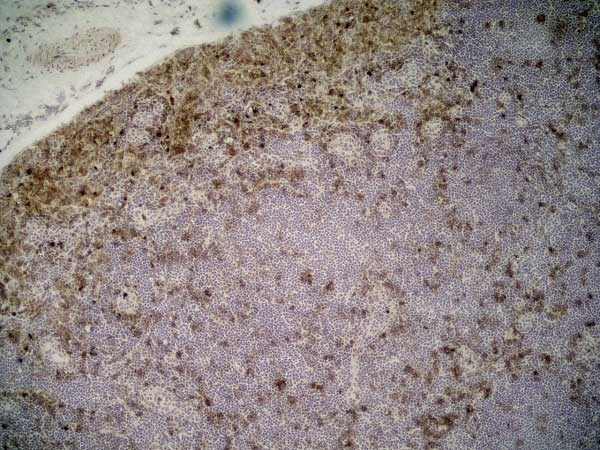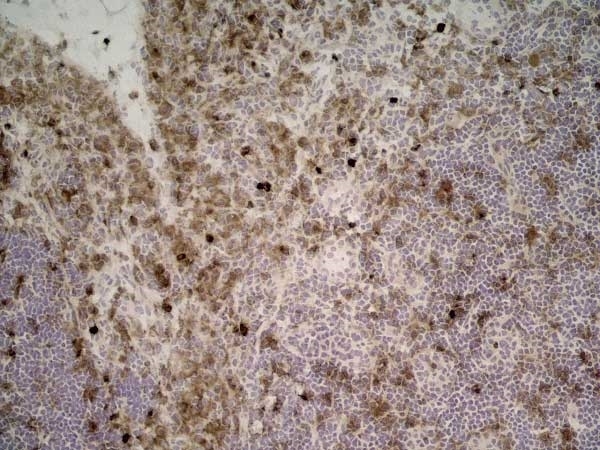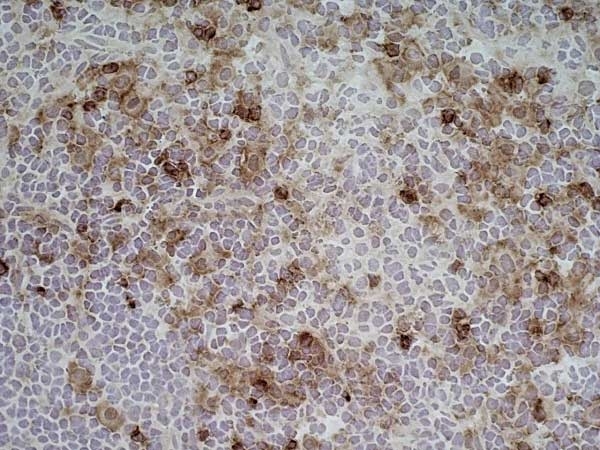CD11b antibody | ED7



Mouse anti Rat CD11b
- Product Type
- Monoclonal Antibody
- Clone
- ED7
- Isotype
- IgG1
- Specificity
- CD11b
| Mouse anti Rat CD11b antibody, clone ED7 recognizes a membrane antigen on rat macrophages, monocytes, dendritic cells and granulocytes. Like ED8, ED7 recognises small ramified microglia in the central nervous system. No other cell types are positive for ED7, except for the cilia of the bronchus epithelium. The recognized antigen is a heterodimer (~160 and ~95 kDa) belonging to the family of adhesion molecules (CD11b/CD18). ED7 and ED8 may recognize closely related epitopes on the same molecule. ED7 and ED8 have been shown to induce homotypic aggregation of granulocytes. |
- Target Species
- Rat
- Product Form
- Purified IgG - liquid
- Preparation
- Purified IgG prepared by affinity chromatography on Protein A from tissue culture supernatant
- Buffer Solution
- Phosphate buffered saline
- Preservative Stabilisers
0.09% Sodium Azide - Carrier Free
- Yes
- Immunogen
- Rat spleen cell homogenate.
- Approx. Protein Concentrations
- IgG concentration 0.5 mg/ml
- Fusion Partners
- Spleen cells from immunized BALB/c mice were fused with cells of the mouse Sp2/0 Ag-14 myeloma cell line.
- Regulatory
- For research purposes only
- Guarantee
- 12 months from date of despatch
Avoid repeated freezing and thawing as this may denature the antibody. Storage in frost-free freezers is not recommended.
| Application Name | Verified | Min Dilution | Max Dilution |
|---|---|---|---|
| Flow Cytometry | |||
| Functional Assays 1 | |||
| Immunohistology - Frozen 2 | 1/500 | ||
| Immunohistology - Paraffin |
- 1This product contains sodium azide, removal by dialysis is recommended prior to use in functional assays.
- 2The epitope recognised by this antibody is reported to be sensitive to formaldehyde fixation and tissue processing. Bio-Rad recommends the use of acetone fixation for frozen sections.
- Flow Cytometry
- Use 10ul of the suggested working dilution to label 106 cells in 100ul.
| Description | Product Code | Applications | Pack Size | List Price | Your Price | Quantity | |
|---|---|---|---|---|---|---|---|
| Mouse IgG1 Negative Control | MCA1209 | F | 0.1 mg |
|
Log in | ||
| List Price | Your Price | ||||||
|
|
Log in | ||||||
| Description | Mouse IgG1 Negative Control | ||||||
References for CD11b antibody
-
DeGroot, C.J. et al. (1988) Discrimination between different types of neuroglial cells in rat central nervous system using combined immuno- and enzyme-histochemical methods.
Immunobiology. 178 (3): 177-90. -
Damoiseaux, J.G. et al. (1989) Heterogeneity of macrophages in the rat evidenced by variability in determinants: two new anti-rat macrophage antibodies against a heterodimer of 160 and 95 kd (CD11/CD18).
J Leukoc Biol. 46 (6): 556-64. -
Damoiseaux, J.G. et al. (1989) Rat bone marrow and monocyte cultures: influence of culture time and lymphokines on the expression of macrophage differentiation antigens.
J Leukoc Biol. 46 (3): 246-53. -
Huitinga, I. et al. (1993) Treatment with anti-CR3 antibodies ED7 and ED8 suppresses experimental allergic encephalomyelitis in Lewis rats.
Eur J Immunol. 23 (3): 709-15. -
Drasković-pavlović, B. et al. (1999) Differential effects of anti-rat CD11b monoclonal antibodies on granulocyte adhesiveness.
Immunology. 96 (1): 83-9. -
Dick, A.D. et al. (2001) Distribution of OX2 antigen and OX2 receptor within retina.
Invest Ophthalmol Vis Sci. 42 (1): 170-6. -
Garn, H. et al. (2006) Phenotypical and functional characterization of alveolar macrophage subpopulations in the lungs of NO2-exposed rats.
Respir Res. 7: 4. -
Ramaglia, V. et al. (2007) The membrane attack complex of the complement system is essential for rapid Wallerian degeneration.
J Neurosci. 27 (29): 7663-72.
View The Latest Product References
- Synonyms
- Integrin Alpha M Chain
- MAC-1
- RRID
- AB_322901
MCA618R
If you cannot find the batch/lot you are looking for please contact our technical support team for assistance.
Please Note: All Products are "FOR RESEARCH PURPOSES ONLY"
View all Anti-Rat ProductsAlways be the first to know.
When we launch new products and resources to help you achieve more in the lab.
Yes, sign me up

